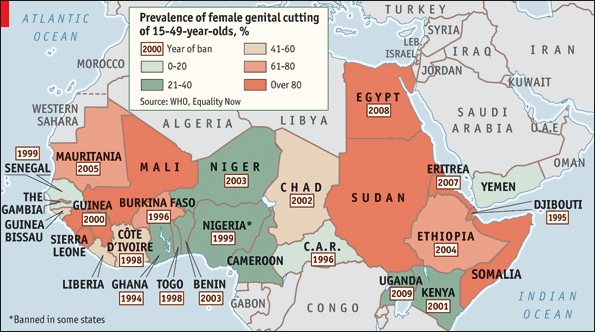The Gap's most cruel--and irreversible--chastity belt
 Friday, July 2, 2010 at 12:02AM
Friday, July 2, 2010 at 12:02AM 
Economist story that neglects the Kurds still doing this in northern Iraq.
Some stunning facts:
Cutting girls’ genitals is still common in 28 mostly African countries and among their migrants abroad. The World Health Organisation (WHO) estimates that 100m-140m women have been subject to the practice and thinks that some 3m girls are at risk each year of one of four forms of cutting, ranging from the symbolic to life-ruining. In countries such as Somalia, Egypt and Guinea, over 95% of women have undergone some version of it.
Some see it as a matter of hygiene, others as a rite of passage into womanhood. Its Muslim, Christian and animist defenders all cite religious grounds. Where the practice is a prerequisite for marriage, economic factors play a role too.
Attempts to stamp out the practice have gathered pace since the 1980s. Now 18 African countries have banned it, although laws are patchily observed. Nawal El Saadawi, an Egyptian who suffered mutilation and has campaigned against it for more than 50 years, says that education is needed, not just prohibition. A mixed approach probably works best. Burkina Faso has a hotline to the police for girls who feel they are in danger. Tasaru Ntomonok Initiative, a group in the Narok district in Kenya, has a safe house for girls fleeing their families. Maendeleo ya Wanawake Organisation, a Kenyan women’s NGO, offers “circumcision through words”, an alternative rite of passage without the bloodshed.
A bigger trend is medicalisation. In the past the procedure was typically performed by a local woman using anything from a razor blade to a piece of broken glass, sometimes even using battery acid to stop the bleeding. More families now ask doctors to carry out the cut, in the hope that this will make it safer. A study in Kenya in 2000 showed that using sterile razors, anti-tetanus shots and antibiotics cut the risk of immediate complications by 70%. Such thinking led to the debate in America about whether using doctors was the lesser of two evils. But campaigners against cutting say the use of professionals undermines efforts to end the practice, as making it safer may encourage more parents to inflict it on their daughters.
The weird argument is hygiene, because the comparison to circumcision is bizarrely inappropriate. It's also strange to see it justified by multiple religions.
To me, the whole thing seems like an crude attempt to control the sexuality of women (Ayaan Hirsi Ali's point), by essentially depleasurizing it. To call it anything else seems like a lie.
I always have a hard time convincing my kids that women basically had no rights in human history until very recently (with most coming in my lifetime, frankly). I also have a hard time convincing them that such conditions are basically unchanged still today in many parts of the world--all Gap.










Reader Comments (1)
The mere thought of this makes me physically ill.